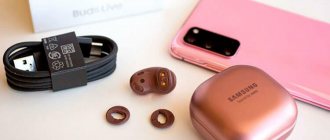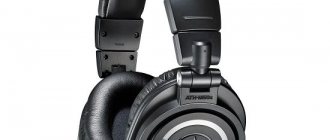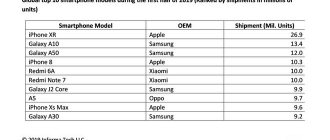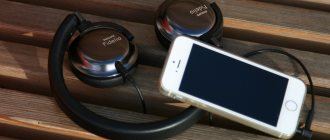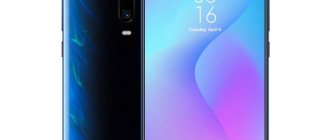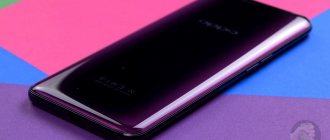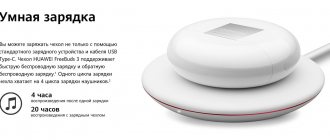The vast majority of Russian users know the OPPO brand exclusively for their decent quality smartphones with very attractive numbers on their price tags. But few people know that this company did not immediately begin producing smartphones. OPPO's first products were high-end DVD players, and later they added Blu-Ray players, amplifiers and headphones of the same level. Nowadays, a separate OPPO Digital department deals with High-End equipment at OPPO, and since May of this year, OPPO Digital products have been officially available in Russia, and a very interesting representative of it has appeared in our test laboratory - not quite ordinary OPPO PM-1 headphones. The price for them may not seem very adequate to many, and what’s more - very inadequate. But to understand whether this is true or not, we will have to take a closer look at the technologies used in this model, and then evaluate their advantages in practice.
⇡#Specifications and hardware features
| OPPO PM-1 | |
| Acoustic type | Open |
| Headphone type | Monitor |
| Head type | Planar magnetic |
| Head size, mm | 85x69 |
| Magnetic system | Symmetrical push-pull neodymium |
| Reproducible frequency range, Hz | 10–50 000 |
| Impedance, Ohm | 32 |
| Input power, W | Max. long term use: 0.5 Peak: 2 |
| Sensitivity, dB per 1 mW | 102 |
| Contact pressure, N | 5 |
| Weight, g (without cable) | 395 |
| Warranty, months | 36 |
| price, rub. | 60 000 |
The OPPO PM-1 headphones are what they call an honest High-End, in which, according to the developers, absolutely everything is designed from scratch, from the speakers to the housing elements. And the main technological feature of OPPO PM-1 is the use of planar magnetic dynamic heads. It is to them that these headphones owe their clear, smooth sound - and their ever-memorable high cost. The planar magnetic technology itself was not developed by OPPO or even in this century. Moreover, headphones with drivers of this type were produced back in the 70-80s of the last century. The terms most commonly used for this group of heads are orthodynamic or isodynamic. Among the leaders in the production of such headphones are such world-famous monsters as Yamaha or Audio Technica, and domestic ones or Amphiton. But then the market was filled with headphones and audio systems with conventional dynamic drivers, and planar magnetic technology was pushed into the back drawer and had already begun to become covered with dust, but in recent years, individual enthusiast companies have tried to resurrect it, the existence of which is often known only to those interested in sound problems for advanced amateurs.
Planar-magnetic (or orthodynamic/isodynamic) differ from simple dynamic heads in that conductors are applied to the diaphragm of their heads, representing a voice coil, which can have a wide variety of shapes. Thus, the coil of planar magnetic drivers is movable. This technology allows headphones based on it to reproduce the quietest, faintest sounds, creating a unique effect of presence, live music at home. Naturally, the recording for this should not be compressed.
As for the heads installed in OPPO PM-1, they are unique not because of the planar magnetic technology itself, but because of their original design. It is based on a neodymium magnet and a seven-layer diaphragm, which, according to the developer, allows you to forget about physical wear, aging and temperature deformation. In addition, to obtain the most accurate reproduction of stereo sound and balance between the right and left channels, the heads of these headphones are additionally matched to each other, and are not randomly selected from the lot.
Dependence of OPPO PM-1 sensitivity on frequency
The OPPO PM-1 model, which is quite high for most planar magnetic headphones with a sensitivity of 102 dB, is partly due to the bilateral arrangement of flat spiral conductors on the diaphragm - on one and the other side of each head. During operation, the diaphragm oscillates symmetrically in a push-pull mode, and these heads have no passive return zone. Well, the flat conductor circuit of the head structure itself, due to the absence of inductive components, allows intermodulation distortion to be minimized.
The relatively high level of sensitivity and low impedance of 32 Ohms allow the OPPO PM-1 to be used not only with home audio systems, but also with mobile devices. Surely many will find it strange to use expensive high-quality headphones in this way, but OPPO sees nothing wrong with the fact that from time to time their owner will listen to music from a smartphone.
Results
OPPO Enco Free are interesting headphones on the TWS device market. At first I thought that it would have the same terrible quality as the Vivo TWS Earphone. But after walking around with headphones for a few weeks, I was a little surprised. They have good sound, what the mass user needs, good battery life and stylish design.
It will be quite difficult to compete with OPPO Enco Free, since today the price is 10,990 rubles, and for this money you can already buy Huawei Freebuds 3, which have better sound, wireless charging and noise reduction. Another competitor is Vivo TWS Neo, which also has better sound and supports the aptx HD codec with Vivo smartphones.
Would I buy an OPPO Enco Free? Definitely not. For 11,000 rubles. there are more interesting options. Perhaps for 8000-9000 rubles. You can already consider purchasing them, especially if you own a smartphone from OPPO.
Oppo Oppo Enco Free
⇡#Supply set
Packaging of OPPO PM-1 headphones
It’s simply impossible not to write separately about the packaging of OPPO PM-1. Having opened a huge, unremarkable cardboard box, we found another cardboard box neatly placed in soft material, with original embossing on the surface, a pleasant greenish tint and slightly smaller dimensions. The inner box has a removable lid and a folding side panel, and the inside is covered with a soft synthetic material that protects another, third, box from scratches, which is hard to even call packaging. It's more of a storage case.
Storage case
The case is made of wood. The outside is varnished, and the inside has a pad for headphones and cables covered with soft fabric. It is noteworthy that there was no place in this case for the other accessories included in the OPPO PM-1 package - they are in the very first cardboard box. The wooden case looks very attractive and even pretentious, but its practicality is deeply questionable. Firstly, compared to headphones, it is simply huge and will take up a lot of free space in the apartment. At the same time, hardly anyone will decide to get rid of an expensive but not very necessary case. Secondly, the case cannot accommodate all the accessories - there is simply no space for them. However, OPPO is not alone in the desire to create unique packaging for its headphones. One of the competitors of the OPPO PM-1 model, planar magnetic headphones from the Californian company Audeze, also comes in a wooden case.
OPPO PM-1 headphones supplied
But let's return to the package. Along with the headphones it included:
- removable cable with 3.5 mm connector, 1 m long;
- removable cable with 6.35 mm connector, 3 m long;
- replaceable set of ear pads;
- compact mobile case;
- fabric cover for cables;
- printed user manual.
It is quite unusual to see an audio cable for connecting to mobile devices and a carrying case included in the delivery of such expensive headphones, but, unlike other manufacturers, OPPO positions its headphones as a model that you can always take with you on a trip.
Case
As for the mobile case, it is made very lightly and modernly, which makes it stand out unusually against the background of the rather austere and expensive look of the headphones themselves. The case has a hard base and closes with a zipper. The inside is lined with soft fabric and the top is covered with denim material. The headphones in the case are placed with the cups rotated 90 degrees, due to which its relatively small dimensions are achieved. At the same time, there is still a little space left inside for both a standard mobile cable and a longer one. Not without difficulty, but we managed to place even the large three-meter cable included in the package next to the headphones.
OPPO PM-1 review. Online magazine “AVREPORT.RU”
OPPO PM-1 undoubtedly belongs to the top league of headphones: the models are chicly made, they are pleasant to hold in your hands, and they sit comfortably on your head. As the manufacturer promised, the headphones are not too demanding on amplification power, however, the higher the quality of the audio components, the better the sound will be. And the musical potential of the PM-1 is enormous, clearly demonstrating why many audiophiles prefer isodynamic headphones
Save and read later -
Peculiarities
The OPPO company, very well known in the DVD and Blu-ray players market, has been purposefully developing the field of personal audio equipment in recent years. And it has already managed to form a good lineup of several types of headphones and amplifiers with a DAC module.
Today, many manufacturers of Hi-Fi acoustics and electronics have paid attention to the personal audio segment, but for most of them, the release of headphones is more of a marketing ploy, an attempt to once again remind themselves, keep up with competitors and grab their small piece of a big and tasty pie. As a rule, companies do not make ambitious plans and follow the beaten path, developing their own versions of headphones with dynamic drivers. OPPO took a different route. Planning expansion in the headphone and related electronics market, the company invested heavily in research and technology, essentially starting the development of headphones from scratch and choosing a rare design with PMD drivers for them.
The abbreviation PMD (Planar Magnetic Driver) translates as “Planar Magnetic Emitter”; sometimes these drivers are also called orthodynamic or isodynamic, emphasizing the principle of their operation. PMD technology in headphones is not new, we can say that its boom occurred in the 70-80s of the last century, when “isodynamics” was actively promoted by the famous Japanese companies Yamaha, Fostex, together with their many followers, among which was the Soviet company Amphiton .
The popularity of isodynamic headphones was due to their accurate sound reproduction. The membranes of PMD drivers are made of a very thin and light film, onto which the conductive paths of the voice coil are evenly applied. The membrane is then suspended parallel to one or two magnetic grids; in the latter case, the membrane is located between the control grids. In this system, the magnetic field forces act uniformly on the entire surface of the membrane, without causing it to bend. In traditional speakers, where the voice coil is attached to the diaphragm at one point, the force is applied only at one point, additional vibrations occur in the cone material, leading to sound distortion. In principle, magnetic planar drivers are somewhat similar to electrostatic loudspeakers, but have their own advantages: for example, they do not require high voltage to polarize the film or stators, they do not have dust problems, and they provide the completely resistive load so desired by amplifiers. At the same time, isodynamic headphones of the last century also had their weaknesses: they were expensive, heavy and insensitive, requiring high output power from amplifiers. Therefore, with the development of dynamic driver technology and the improvement of their sound quality, headphones on magnetic “planars” gradually faded into the shadows. Some manufacturers continued to make isodynamics, such as Audeze and HiFiMan, but the technology left the mainstream. However, OPPO was not frightened by the problems of planar magnetic emitters; on the contrary, it encouraged them to search for ways to solve them. History is cyclical: at one time technology helped the progress of dynamic drivers, but now new technologies will help the development of isodynamic drivers.
as an exclusive item, OPPO PM-1 is delivered in a varnished wooden box.
Thus, the main task of OPPO engineers was formulated simply - to increase the efficiency of planar magnetic emitters. For this purpose, a unique 7-layer membrane with a double-sided voice coil was developed, the turns of which are rolled into flat spirals. The emitter also requires a powerful magnetic system. In the old days, such a system was made up of ferrite lattices, large and heavy, but today the rare earth element neodymium, which has excellent magnetic properties, is used for these purposes. Neodymium magnets with the same strength are much more compact and lighter than ferrite ones. OPPO planar emitters use two neodymium gratings at once, providing push-pull control of the membrane. Doubling the voice coils and magnetic systems significantly increased the sensitivity of the drivers, which amounted to 102 dB, reaching the level of the best headphones with dynamic drivers. Now OPPO headphones do not need specially selected, powerful amplifiers. In addition, the creators of OPPO headphones managed to reduce their weight and impedance (32 Ohms), making it possible to use them with portable players.
The PM-1 is distinguished by a rich finish: elements of the headband and cups are machined from aluminum, and the ear pads are covered with lambskin.
The cups have several degrees of freedom, so the headphones sit comfortably on the head. We tested the flagship OPPO headphones, models PM-1, equipped with cups with an open design and oval-shaped isodynamic drivers (85x69 mm). The headphones are distinguished by an elegant appearance, rich finishing and equipment. Elements of the headband and cups are machined from aluminum, the ear pads and headband are covered with lambskin, and latex is used in the pads. The cups have several degrees of freedom, rotating around a vertical and horizontal axis, so they easily adapt to the owner’s head. An extendable headband, large and soft ear pads that completely cover the ears make the PM-1 very comfortable and lightweight, and the weight of the model (excluding cable) is only 395 g.
PM-1 drivers are equipped with unique 7-layer membranes with a double-sided voice coil, the turns of which are rolled into flat spirals.
OPPO PM-1 leather ear pads can be replaced at any time with velor ones (replacement ear pads are included). The ear pads are attached to four rubber feet and are very easy to remove and put on. The package included with the PM-1 deserves special mention. The headphones are placed in a wooden box, varnished and trimmed with mahogany veneer. There is a fabric bag with cables in a recess next to the headphones. The wooden box is, so to speak, the permanent home of the headphones, but for travel a branded fabric bag with a zipper is offered. The main package also includes two replacement cables: a 3-meter cable with a 6.3 mm connector and a meter cable for portable players with a 3.5 mm connector.
Along with the headphones, the kit includes replacement cables, ear pads, etc.
As an additional option, OPPO offers balanced cables of various lengths for its isodynamic headphones. To use such a cable, you will have to buy it, in addition, you will need an amplifier with a 4-pin socket (the OPPO HA-1 amplifier has this output), but believe me, the purchase will be worth it. However, we will talk about this in the impressions section.
Short description
OPPO PM-1 undoubtedly belongs to the top league of headphones: the models are chicly made, they are pleasant to hold in your hands, and they sit comfortably on your head. As the manufacturer promised, the headphones are not too demanding on amplification power, however, the higher the quality of the audio components, the better the sound will be. And the musical potential of the PM-1 is enormous, clearly demonstrating why many audiophiles prefer isodynamic headphones. The only limiting factor for OPPO PM-1 is the issue of price. If the cost of the PM-1 seems prohibitive, you can pay attention to their twins, the OPPO PM-2 models, which use exactly the same technologies, but simpler materials and no advanced configuration.
Impression
proprietary combination: OPPO PM-1 headphones and OPPO HA-1 amplifier/DAC
We tried the OPPO PM-1 headphones in several audio systems, making sure that they can handle amplifiers of different powers. The headphones were connected to the native OPPO HA-1 amplifier/DAC and to a two-component system from the Australians Burson Audio DA-160/HA-160 - all these devices are capable of driving any headphones. However, the PM-1 also sounded good with the miniature Audioengine D3 amplifier, not as impressive as with desktop components, but also very respectable and musical.
PM-1 is distinguished by a very comfortable presentation of musical material, a luxurious timbre palette and a genuine richness of emotional shades of performance. The naturalness of the sound is beyond praise. Intelligibility of sound in all ranges, pleasant warmth and relaxedness - the headphones play unobtrusively, in the sense that they do not attract attention with deliberate brightness or scale of space, but their ability to subtly work with details and intonations quickly captivates, you want to listen to music again and again.
The volume of the musical stage is not record-breaking, but the images are taken out of the head, well separated and localized, so that the sound image is contrasting, stable, and the background can be easily distinguished. Even orchestral and choral fragments with serious dynamics do not in any way affect the harmony and clarity of the musical composition - it is always beautiful.
The headphones have a very beautiful bass: deep, elastic, fast, bas-relief textured. They impeccably keep the rhythm and convey the timbre features of the sound of instruments from the lower registers of a concert grand piano to tuba, double bass or even organ. Yes, yes, usually an organ in headphones sounds emasculated and uninteresting, but the PM-1 were able to convey, if not the breath of large pipes in a cathedral, then at least the legible multi-dimensionality of the sound of this instrument.
The dynamic playback performance of the OPPO PM-1 is definitely good, although in presenting extreme degrees of attack and amplitude, the headphones give preference to nuances, somewhat holding back strength and power. This is partly why the headphones lack drama and expression when playing the most energetic music. Because of this feature, the headphones can hardly be accused of genre bias; it’s just that if the most important thing for a music lover is the feeling of musical drive, then for the same money you can try other models.
Another feature of the OPPO PM-1 is its slightly darkened top. The impression is not so much about general intelligibility - everything is in perfect order with it - but about musical accents, which are smoothed and softened: the sound has less airiness, shine of cymbals and percussion.
balanced cable for OPPO PM-1 headphones
In conclusion, let’s talk about the promised experiment with a balanced cable. How can you easily improve the sound of headphones that already play great? Connect the OPPO PM-1 to the amplifier via “balance” (in our case, to the OPPO HA-1, which has a balanced headphone output). There is only one downside to the OPPO balanced cable - it costs money, the rest are advantages. The remarkable potential of the PM-1 is revealed much more fully: detail, localization, and volume are improved (it seemed that the width of the stage remained approximately the same, but the depth increased dramatically). The articulation and density of the bass suddenly increases: the dynamic range of playback predictably improves, but the degree of improvement was surprising. The sound becomes even more sensual and touching, especially when it comes to vocal reproduction. Perhaps, with a balanced connection, OPPO PM-1 acquires that missing drama and bass energy needed to pump up heavy rock. Only the treble notes are still slightly lacking in brightness and sharpness, otherwise the headphones could be called ideal.
TEST STAND
- DAC/Amplifier: OPPO HA-1, Audioengine D3
- DAC: Burson Audio DA-160
- Amplifier: Burson Audio HA-160
- USB cable: QED Digital USB
- Interconnect cables: Nordost Blue Heaven flatline (RCA)
Prepared based on materials from the online magazine “AVREPORT.RU”, April 2020 www.avreport.ruThis review has been read 3,528 times.
⇡#Appearance and ergonomics
It's no secret that the design of monitor headphones most often becomes a victim of practicality. On the one hand, this is correct, because it’s not customary to show off such headphones in the subway or on the street, and the comfort of wearing directly determines how the user perceives the sound - will he strain with all his might because something is pressing somewhere, or will he relax and forget about everything for a couple of hours. On the other hand, it is always nice to pick up a beautiful thing with an attractive appearance. The developers at OPPO tried to combine practical convenience with a nice design, and they did it quite well.
Appearance of OPPO PM-1 headphones
The OPPO PM-1 model looks as expensive as possible. When you first meet her, for some reason you immediately imagine a neatly dressed gentleman who, having taken off his jacket and tie at the end of the working day, sits in a chair and enjoys jazz in these headphones. Such thoughts are suggested by the simple shapes and uncomplicated lines of the design elements of the headphones, as well as the attractive combination of silver metal and black soft sheepskin, pleasant to the touch.
Appearance of cups
Cups turned to extreme positions
Cup rotating mechanism
In general, when you pick up the OPPO PM-1, you immediately understand that these are not ordinary headphones. Their design contains a minimum of plastic elements. Only part of the cup body is made of this material, and all other parts are metal. The cups also have metal inserts, covered on the outside with a fine metal mesh painted black. They deviate at a small angle relative to the vertical plane in massive metal O-shaped frames, fixed to the headband on metal hinges, allowing the cups to rotate around their axis in one direction by 90, and in the other by approximately 80 degrees.
Arms in folded and unfolded states
The headband is also made of metal. Its internal part is a flat sliding rail with a steel base and a very clear discrete movement. When extending or sliding the headband, the user hears a characteristic click, and the movement itself occurs so smoothly that it seems as if machine oil had been poured into the headband.
Headband
Ear pad design
The outside of the headband is covered with really soft, almost velvety sheepskin. The main ear pads are covered with exactly the same leather, but, unlike the headband, the leather has neat perforations. Inside, the headband and ear pads are filled with natural latex, which is particularly soft, which is rarely found in these design elements of other monitor headphones.
Attachment of ear pads and internal design of cups
The ear pads are attached to the cups with four plastic pins that snap into place when pressed somewhere in the bowels of the metal body of the cups. To remove the ear pads from the cups, you need to apply a relatively large force, so they certainly cannot fly off on their own. Well, the internal design of the cups and the emitter located in its center evoke only respect. Everything is made carefully, without the slightest defect, and it looks very beautiful.
Comparison of leather and velor ear pads included in the package
The second pair of ear pads is structurally no different from the main one. Only the material that covers the latex filler has been changed. Instead of leather, these ear pads use soft-touch velvet fabric.
Like many other top-end monitor headphones, the OPPO PM-1 model has a detachable audio cable, the connectors for which are located at the bottom of each earcup. Uses 2.5mm mono jacks. As for the cables included in the package, it’s quite difficult to find fault with the quality of their manufacturing. The main three-meter cable with a 6.35 mm connector is dressed in a fabric case and, thanks to its large cross-section, is not subject to tangling. The second cable with a 3.5 mm connector looks less solid, but there are no complaints about its quality. It's thin, but also tangle-free thanks to the soft braid material.
OPPO PM-1 headphones with main audio cable connected
OPPO PM-1 headphones with connected mobile audio cable
Overall, the workmanship and appearance of the OPPO PM-1 is simply impeccable. It is unlikely that there will be many potential users who will be indifferent to the proportional shapes of these headphones and the high-quality materials from which they are made, because in this case it is clearly visible that they worked on the design (in the full sense of the word) of this model for not an hour, not a day, and not even a week. And despite the use of expensive materials in the decoration, the appearance of the OPPO PM-1 cannot be called too pretentious or too pretentious - everything about these headphones is strict and extremely practical. But appearance alone cannot justify such a price - headphones must be comfortable, and most importantly, they must also sound.
Unpacking and packaging
The new TWS headphones come in a small white box. Where on the front there is a picture of the headphones, the name of the model and the company. On the back of the box there is a list of their technical features. These include Bluetooth version 5.0, 20 hours of battery life, touch control, water protection and much more.
Inside the box there is a charging box with headphones inside. And at the bottom of the box there is a Type-C charging cable, ear pads and instructions for use.
As you may have noticed, the box and instructions are only in Chinese. Therefore, the instructions will be of little use. But despite this, the box itself is quite high quality and does not look poor. In general, for its initial price, I liked the package. Now I want to tell you my opinion about the build quality and fit.
⇡#Impressions from use
The thoughtful design of the headband and cups, as well as the adjustable headband, allowed the OPPO PM-1 headphones to very accurately fit the user's head, regardless of its size. The ear pads are not too large, but the ears fit into them quite easily. Well, due to the use of natural latex as padding, the headphones sit so softly on the head that discomfort does not occur even after several hours of continuous listening. At the same time, the headphones do not fly off or move on the head during sudden movements. Perhaps this is one of the most successful designs of monitor headphones, in which a stylish design is successfully combined with the practicality of the case.
Being open, OPPO PM-1 practically does not isolate the listener from external noise. You can also hear the music being played outside quite well, but for headphones of this type this can hardly be considered a disadvantage. In general, using the OPPO PM-1 left only the most pleasant impressions.
Connection and communication
The pairing process for OPPO Enco Free varies depending on the smartphone. With OPPO models, just open the lid and a pop-up menu for connecting will appear on the screen. With devices from other brands, you must hold the button on the charging case until the LED indicator flashes. However, all subsequent pairings occur when the case is opened.
Photo: Artyom Bagdasarov / Lifehacker
The headphones maintain connection at a distance of up to 10 m from the smartphone. You can go into the next room from the Bluetooth source, and the connection will still be stable. There is also no interference on the street. There are no problems with synchronizing the left and right channels - both devices operate in parallel and independently of each other.
Each earbud is equipped with two microphones, and a built-in processor suppresses background noise so that your voice can be heard clearly. The latter do not complain about transmission quality even in noisy places.
⇡#Sound quality
Sennheiser HD 800 headphones
Beyerdynamic DT 990 PRO headphones
The operation of the headphones was tested by connecting them to an external M-Audio Conectiv sound card, as well as to several mobile devices. Willy-nilly, you expect something amazing from these headphones, and therefore the attitude towards them was initially somewhat biased. To try to be as objective as possible, it was decided to compare the OPPO PM-1 model with other open-back monitor headphones. Unfortunately, there were no planar magnetic headphones in our collection, but we did find the flagship of the Sennheiser line - the Sennheiser HD 800 model, the cost of which, although less than that of our guest today, is at least aspiring to that. In addition, we compared the sound of OPPO PM-1 with Beyerdynamic DT 990 PRO headphones.
We listened to classical music, jazz, rock of varying degrees of severity, music of various styles close to popular, ska, various vocals and much more, right up to chanson and art songs, may the developers and readers forgive us. Well, to make testing more interesting, there were several test listeners. There were no true audiophiles among them, but none of them even saw bears in childhood, not to mention the direct contact of the subjects’ ears with this animal. The result turned out to be quite predictable - opinions differed, and in many ways quite strongly. This once again proves that there is no recipe for ideal sound, just as there are no absolutely identical preferences. But this does not mean that there are no objective things on which all testers agreed.
Let's start with the fact that the OPPO PM-1 headphones are distinguished by clean, smooth sound with bright, pronounced mids. Almost any composition with a more or less decent recording acquires volume and airiness, but the vocals are the most expressive. Even in an MP3 recording you can feel such a sound picture: the vocalist’s voice acquires a noticeable volume and appears directly in front of you, and the accompaniment comes from somewhere behind - the instruments seem to be located in a semicircle in front of the listener. Something similar, but less pronounced, is observed when listening to music from the Sennheiser HD 800, with the only exception that the above-mentioned volume and space are felt to a lesser extent. With the Beyerdynamic DT 990 PRO and other headphones, you don't feel anything like that.
Only the OPPO PM-1 and Sennheiser HD 800 were able to reproduce sounds that were not audible on either the Beyerdynamic DT 990 PRO or other headphones. For example, only these headphones reproduced the natural sounds of a recorder, imperfect in nature and therefore truly beautiful. The slightly wheezing (or whistling, whatever you like) sounds of wood sounded a little brighter on the OPPO PM-1, while the Sennheiser HD 800 sounded a little more restrained. We couldn't hear anything like this with the Beyerdynamic DT 990 PRO.
In general, the latest model of headphones performed best when working with heavy music, which has plenty of bass. The OPPO PM-1 and its main competitor from our little comparison test are much more omnivorous, but they sound completely different. Both headphones are distinguished by very high clarity of sound transmission and reproduce the smallest details throughout the entire operating frequency range. But at the same time, the Sennheiser HD 800 sounds restrained and calm, while the OPPO PM-1, in comparison, colors the sound in bright colors, making it more lively and rich. This is especially true for mid and high frequencies, which is strongly felt when playing vocals.
In OPPO PM-1, jazz and music similar to it seems bright and rich. The heavy one feels more restrained. But the instrumental genre can even surprise in some ways. As with vocals, these aspects of sound are revealed here that can only be heard live - a very unusual sensation. At the same time, not only a lossless track or an uncompressed recording, but even MP3 music can sound new. Of course, the full potential of the OPPO PM-1 can only be revealed with high-quality uncompressed recordings played on decent equipment. But this does not mean at all that you cannot enjoy listening to your favorite music on your smartphone with these headphones, no matter how crazy it may sound to a true audiophile.
Summing up the results of our comparative testing, we note the omnivorous nature of the OPPO PM-1 headphones, as well as their brighter color palette and soundstage volume compared to the Sennheiser HD 800, which is distinguished by a soft and restrained sound. It is also worth noting the impeccable performance of OPPO PM-1 in the low frequency range. The bass in these headphones does not drown out the main stage, as is often the case with other models, but at the same time the clarity of their reproduction and richness are no worse than the sound at mid and high frequencies.
Design, ergonomics
OPPO Enco Free are made in the form of earbuds. The design of the headphones is similar to their competitors, but at the same time, both the case and the headphones have distinctive features.
Let's look at the case from all sides. The charging case is made in a rectangular shape, with all corners rounded. An aluminum insert with the OPPO logo is installed on the front part, and an LED is also built into it. The pairing button is round, plastic, and is located on the right side of the edge. The USB-C charging port is located at the bottom; there is no wireless charging.
The cover of the case looks quite massive, but at the same time it feels flimsy. The mechanism connecting the lid and the rest of the case is quite good. During the 3 weeks of testing, it did not creak or make various unpleasant sounds.
Let's move on to the main part.. OPPO Enco Free headphones are in-ear headphones with silicone ear pads. This combination allows the headphones to fit more comfortably in your ears. The kit includes several types of attachments: the largest ones - for better noise reduction; the second - with high breathability. Personally, I preferred the standard ones, since the stock ones keep the golden mean between noise reduction and breathability.
Both headphones have a touch surface. On the left, if you swipe up or down, you can adjust the volume level, on the right, you can switch tracks. By double tapping the right earpiece, you can either answer a call or turn the music on and off. The controls are clear and the surface is responsive to touch. I saw something similar on the terrible Vivo TWS Earphone.
Among other things, the headphones are certified to the IPX4 standard. They are not afraid of direct splashes, but you should not swim or wash them in water.
⇡#Conclusions
OPPO PM-1 headphones are a model with bright, impressive and detailed sound. They are suitable for almost any music, but most of all they reveal their capabilities in the instrumental genre, jazz and vocals. However, this does not at all prevent you from imbuing with them the spirit of a slightly out-of-tune guitar with a recording of some young author from the Grushinsky Festival and catching the subtle sounds of the slightly trembling voice of the vocalist. The effect of presence is the main trump card of OPPO PM-1. It won't be easy to find headphones that can do the same. Well, if you find it, then the cost of the analogue will be, if not higher, then at least comparable to what they ask for the PM-1.
When we first got acquainted with the OPPO PM-1, we were very skeptical about headphones for a price close to the cost of a used Zhiguli (or a very good bicycle, depending on your taste). But working with them dispelled our doubts. Don't think that you need to be a true audiophile to appreciate all the capabilities of this model. Of course, OPPO PM-1 is a headphone for enthusiasts. But anyone who decides to purchase them will be satisfied with the purchase and will discover completely new horizons of sound. Moreover, he will be able to do this not only with High-End players, but even with a smartphone or any portable player, no matter how creepy this may sound for many. Overall, the OPPO PM-1 is a very, very good pair of headphones. But whether they, or indeed any headphones in general, are worth the 60,000 rubles that are asked for them is up to you to decide.
Autonomy OPPO Enco Free TWS
The new OPPO Enco Free can work a little more than 4 hours on a single charge. The case itself is capable of fully recharging the headset 4 more times, which in total gives us more than 20 hours of operation. In normal use, this lasted me a week.
The battery here is quite durable, but there is no wireless charging. The complete process of recharging the headphones through the case takes about an hour. The case itself is replenished with energy via a USB-C cable, the entire process takes about two hours. There is no wireless charging yet, although there is hope that it will appear in future models from OPPO.
